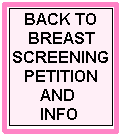White Paper on Mammography
MAMMOGRAPHIC SCREENING FOR WOMEN AGED 40-49
By Marita Acheson, M.D.
Screening mammography searches for breast cancer in asymptomatic women,
that is, women with no signs or symptoms of breast cancer. There has
been much publicized debate about the possible benefits of screening
mammography for women aged 40-49. The Seattle Breast Center
Multi-disciplinary Team, which consists of 26 physicians, including
Surgeons, Medical and Radiation Oncologists, Radiologists, Pathologists
and Plastic Surgeons, strongly recommends annual mammographic screening
for women in their forties. In April 1997, the American Cancer Society (ACS)
changed its recommendations for screening mammography to every year from
age forty.
It is well documented that the overall prognosis for survival of women with breast cancer depends on a number of factors, including the following:
- The larger the cancer, the higher the breast cancer mortality. When cancers found are less than 1cm in size, over 96% are cured.
- Increased spread to lymph nodes increases breast cancer mortality.
- Cancer spread to lymph nodes occurs more frequently with increasing tumor size.
- The higher the tumor grade (the more aggressive the cancer), the higher the breast cancer mortality.
- When cancers are less than 1.0 cm in diameter, the effect of tumor grade on mortality disappears.
These factors have been shown to hold true for all women with breast cancer, no matter what the age of diagnosis. Breast cancer tends to grow faster in pre-menopausal than in post-menopausal women. It is important for the time interval between screening mammograms to be short enough so cancers can be found while they are still small enough to be curable. If a woman waits too long from one screening exam to the next, there is sufficient time for a cancer to become large enough to spread. Therefore, we recommend mammographic screening every year from age 40.
Those who hold a viewpoint that screening mammography does not benefit women ages 40-49 have said there is no scientific proof of benefit. This is only half the picture. In reality, no single study has ever been properly designed and conducted as a randomized controlled trial, with enough women aged 40-49 to either prove or disprove benefit. META analysis, which combines data from several different studies, has shown a 23% benefit of reduction of mortality to women invited for screening, with statistical significance confidence level greater than 95%. This excludes results from the Canadian National Breast Screening Study, which was compounded with many problems. There is still a 14% reduction in mortality with screening mammography when including the Canadian National Breast Screening Study results (with statistical significance less than 95% confidence level). These figures include all women asked to participate in regular screening for the trial even if they declined to have a mammogram. The reduction in mortality would be higher if only women who actually had mammograms were counted in the statistics. It is anticipated that studies with newer technology will show considerably better mortality rate reductions than these older studies.
Why is all the debate about this issue so important? There are 15 million women in the USA between the ages of 40 and 50. About 184,000 women in American were diagnosed with breast cancer last year. In 1996, about 33,400 women aged 40-49 were diagnosed with breast cancer (18.1% of all breast cancers), compared to 30,900 women aged 50-59 (16.8% of all breast cancers). A woman at the age of 40 has a 1.55% chance or 1 in 65 chance of developing breast cancer over the next ten years. It has been estimated that about 40% of all the years of life lost to breast cancer is lost from women aged 40-50. Delayed diagnosis of breast cancer in this group results in enormous social economic impact.
Mammography is not a perfect examination and does not identify all breast cancers early enough for a cure. Mammography will detect many breast cancers long before they are large enough to be felt and when many are curable. In the BCDDP study (1973-81), 45% of all cancers detected in the 40-49 year old group, were detected by mammography alone and could not be found with clinical exam. This compared to 47% detected by mammography alone in the 50-59 year old group. Although mammography is not quite as sensitive in the 40-49 year old group than for the 50-59 year old group, it has proven ability to detect breast cancer too small to be felt. Some breast cancers, however, can still be felt more readily than visualized with mammography so annual physician examination is an integral part of the breast exam. Radiologists (physicians), highly skilled in detecting the subtle signs of breast cancer and stringent quality assurance are necessary for the early detection of breast cancer. The American College of Radiology (ACR) evaluates and now accredits mammography centers.
Seattle Breast Center recommendation:
- Mammographic screening to begin by age 40 and annually thereafter.
- Physician exam every three years for women age 20-40 and ever year for women 40 and older
- Patient to practice monthly breast self exam at the age of 20 and over.
For women with a strong family history of breast cancer (first degree
relative or multiple second degree relatives) consult with your
physician. Taking this into consideration screening mammography before
the age of 40 may be recommended. If you are over age 40 and have not
had your screening mammogram for one year or more, schedule this
important appointment now. © 200
